All the solutions provided in McGraw Hill Math Grade 5 Answer Key PDF Chapter 3 Lesson 3 Two-Digit Dividends will give you a clear idea of the concepts.
McGraw-Hill My Math Grade 5 Answer Key Chapter 3 Lesson 3 Two-Digit Dividends
Example 1
Eli donates his toys to 5 different charities. He has a total 75 toys to donate. Eli donates the same number of toys to each charity. How many toys does each charity receive?
Let t represent the number of toys each charity receives.
_____ ÷ ___ = t
Find 75 ÷ 5.
1. Divide the tens. 7 ÷ 5 Write 1 in the quotient over the tens place.
2. Multiply. 5 × 1
subtract. 7 – 5
3. Bring down the ones.

4. Divide the ones.
25 ÷ 5
Write 5 in the quotient over the ones place.
5. Multiply 5 × 5
Subtract. 25 — 25
The model shows 5 groups of fifteen.
So, 75 ÷ 5 = ____
Each charity receives ____ toys.

Answer:
Each charity receives 15 toys.
Explanation:
Divide the tens. 7 ÷ 5 Write 1 in the quotient over the tens place.
Multiply. 5 × 1
Subtract. 7 – 5 = 2
Bring down the ones.

Divide the ones.
25 ÷ 5
Write 5 in the quotient over the ones place.
Multiply 5 × 5 = 25
Subtract. 25 – 25 = 0
The model shows 5 groups of fifteen.
So, 75 ÷ 5 = 15
Each charity receives 15 toys.
Example 2
Caleb is putting his baseball cards in an album. He has 57 cards and can put 4 cards on each page. How many full pages will Caleb have? Will there be any cards left?
Find 57 ÷ 4.
1. Divide the tens.
5 ÷ 4
Write 1 in the quotient over the tens place.
2. Multiply. 4 × 1
Subtract. 5 – 4
Compare. 1 < 4
3. Bring down the ones.
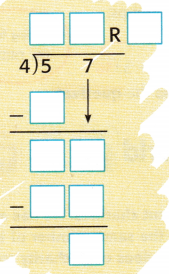
4. Divide the ones.
17 ÷ 4
Write 4 in the quotient over the ones place.
5. Multiply.4 × 1
Subtract. 17 – 16
Compare. 1 < 4
The remainder is ____
So, there will be ___ full pages and ____ card will be left over.
Answer:
14 full pages and 1 card left.
Explanation:
Divide the tens.
5 ÷ 4
Write 1 in the quotient over the tens place.
Multiply. 4 × 1 = 4
Subtract. 5 – 4 = 1
Compare. 1 < 4
Bring down the ones.

Divide the ones.
17 ÷ 4
Write 4 in the quotient over the ones place.
Multiply. 4 × 1 = 4
Subtract. 17 – 16 = 1
Compare. 1 < 4
The remainder is 1.
So, there will be 14 full pages and 1 card will be left over.
Guided Practice
Question 1.

Answer:
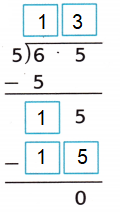
Explanation:
Divide the tens. 65 ÷ 5 Write 1 in the quotient over the tens place.
Multiply. 5 × 1 = 5
Subtract. 6 – 5 = 1
Bring down the ones.
Divide the ones.
15 ÷ 5
Write 3 in the quotient over the ones place.
Multiply 5 × 3= 15
Subtract. 15 – 15 = 0
So, 65 ÷ 5 = 13
Question 2.
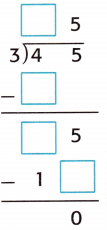
Answer:
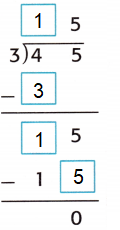
Explanation:
Divide the tens. 45 ÷ 3 Write 1 in the quotient over the tens place.
Multiply. 3 × 1 = 3
Subtract. 4 – 3 = 1
Bring down the ones.
Divide the ones.
15 ÷ 3
Write 5 in the quotient over the ones place.
Multiply 5 × 3= 15
Subtract. 15 – 15 = 0
So, 45 ÷ 3 = 15
Talk Math
What should you do if the remainder is greater than or equal to the divisor?
Answer:
If the remainder is greater than or equal to the divisor,
the divisor can continue to be divided into it.
Explanation:
If a remainder is more than divisor, it can go one more time and division is not complete.
Even if remainder is equal to divisor, it can still go one more time.
Hence remainder has to be less than the divisor.
Independent Practice
Divide.
Question 3.
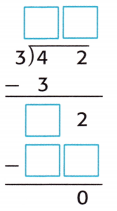
Answer:

Explanation:
Divide the tens. 42 ÷ 3 Write 1 in the quotient over the tens place.
Multiply. 3 × 1 = 3
Subtract. 4 – 3 = 1
Bring down the ones.
Divide the ones.
12 ÷ 3
Write 4 in the quotient over the ones place.
Multiply 4 × 3= 12
Subtract. 12 – 12 = 0
So, 42 ÷ 3 = 14
Question 4.
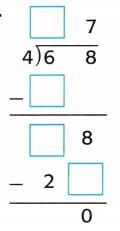
Answer:

Explanation:
Divide the tens. 68 ÷ 4 Write 1 in the quotient over the tens place.
Multiply. 4 × 1 = 4
Subtract. 6 – 4 = 2
Bring down the ones.
Divide the ones.
28 ÷ 4
Write 7 in the quotient over the ones place.
Multiply 7 × 4= 28
Subtract. 28 – 28 = 0
So, 68 ÷ 4 = 17
Question 5.
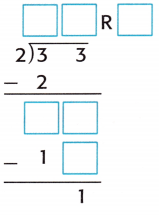
Answer:
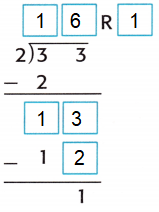
Explanation:
Divide the tens.
3 ÷ 2
Write 1 in the quotient over the tens place.
Multiply. 2 × 1 = 2
Subtract. 3 – 2 = 1
Compare. 1 < 3
Bring down the ones.
Divide the ones.
13 ÷ 2
Write 6 in the quotient over the ones place.
Multiply. 6 x 2 = 12
Subtract. 13 – 12 = 1
Compare. 1 < 12
The remainder is 1.
Question 6.
![]()
Answer:
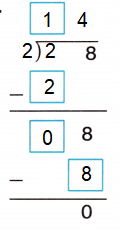
Explanation:
Divide the tens. 28 ÷ 2 Write 1 in the quotient over the tens place.
Multiply. 2 × 1 = 2
Subtract. 2 – 2 = 0
Bring down the ones.
Divide the ones.
8 ÷ 2
Write 4 in the quotient over the ones place.
Multiply 2 × 4 = 8
Subtract. 8 – 8 = 0
So, 28 ÷ 2 = 14
Question 7.
![]()
Answer:

Explanation:
Divide the tens.
7 ÷ 6
Write 1 in the quotient over the tens place.
Multiply. 6 × 1 = 6
Subtract. 7 – 6 = 1
Compare. 1 < 6
Bring down the ones.
Divide the ones.
14 ÷ 6
Write 2 in the quotient over the ones place.
Multiply. 6 x 2 = 12
Subtract. 14 – 12 = 2
Compare. 2 < 12
The remainder is 2.
Question 8.
![]()
Answer:

Explanation:
Divide the tens.
8 ÷ 7
Write 1 in the quotient over the tens place.
Multiply. 7 × 1 = 7
Subtract. 8 – 7 = 1
Compare. 1 < 7
Bring down the ones.
Divide the ones.
15 ÷ 7
Write 2 in the quotient over the ones place.
Multiply. 7 x 2 = 14
Subtract. 15 – 14 = 1
Compare. 1 < 14
The remainder is 1.
Question 9.
60 ÷ 4 = ___
Answer:
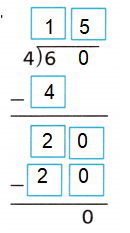
Explanation:
Divide the tens. 60 ÷ 4 Write 1 in the quotient over the tens place.
Multiply. 4 × 1 = 4
Subtract. 6 – 4 = 2
Bring down the ones.
Divide the ones.
20 ÷ 4
Write 5 in the quotient over the ones place.
Multiply 5 × 4 = 20
Subtract. 20 – 20 = 0
So, 60 ÷ 4 = 15
Question 10.
64 ÷ 5 = ___
Answer:
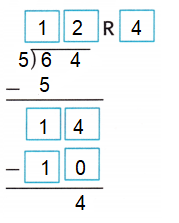
Explanation:
Divide the tens.
6 ÷ 5
Write 1 in the quotient over the tens place.
Multiply. 6 × 1 = 6
Subtract. 6 – 5 = 1
Compare. 1 < 6
Bring down the ones.
Divide the ones.
14 ÷ 5
Write 6 in the quotient over the ones place.
Multiply. 5 x 2 = 10
Subtract. 14 – 10 = 4
Compare. 4 < 14
The remainder is 4.
Question 11.
70 ÷ 6 = ___
Answer:

Explanation:
Divide the tens.
7 ÷ 6
Write 1 in the quotient over the tens place.
Multiply. 6 × 1 = 6
Subtract. 7 – 6 = 1
Compare. 1 < 6
Bring down the ones.
Divide the ones.
10 ÷ 6
Write 1 in the quotient over the ones place.
Multiply. 6 x 1 = 6
Subtract. 10 – 6 = 4
Compare. 4 < 6
The remainder is 4.
Algebra Divide to find the unknown number in each equation.
Question 12.
48 ÷ 3 = h
h = ____
Answer:
h = 16
Explanation:
To isolate the variable in algebra we use inverse operations to manipulate the equation.
So, multiplication is the inverse of division and vice-versa.
48 ÷ 3 = h
h = 16
16 x 3 = 48
Question 13.
44 ÷2 = b
b = ___
Answer:
b = 22
Explanation:
To isolate the variable in algebra we use inverse operations to manipulate the equation.
So, multiplication is the inverse of division and vice-versa.
44 ÷ 2 = h
h = 22
22 x 2 = 44
Question 14.
72 ÷ 4 = w
w = ___
Answer:
w = 18
Explanation:
To isolate the variable in algebra we use inverse operations to manipulate the equation.
So, multiplication is the inverse of division and vice-versa.
72 ÷ 4 = w
w = 18
18 x 4 = 72
Problem Solving
Question 15.
Maranda practiced a total of 52 hours in 4 weeks to prepare for a piano recital. If she practiced the same number of hours each week, how many hours did she practice each week?
Answer:
13 hours each week.
Explanation:
Maranda practiced a total of 52 hours in 4 weeks to prepare for a piano recital.
Number of hours she practice each week 52 ÷ 4 = 13
Question 16.
Mathematical PRACTICE 4 Model Math Five students volunteered to carry boxes. There are 62 boxes. Is it possible for each student to carry the same number of boxes and have all the boxes carried? Explain.
Answer:
No, all the boxes are not carried.
Yes, it is possible for each student to carry the same number of boxes.
Explanation:
Five students volunteered to carry boxes.
There are 62 boxes.
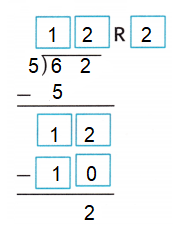
Hot Problems
Question 17.
Mathematical PRACTICE 2 Reason The following equations show the relationship between multiplication and division.
18 ÷ 3 = 6 3 × 6 = 18
18 ÷ 0 = ? 0 × ? = 18
Explain why it is not possible to divide by zero.
Answer:
Because 0 has no multiplicative inverse.
Explanation:
Division by zero with any number is undefined.
The word division means splitting something into equal parts or groups.
So, that it is shared evenly among everyone.
Whereas the value of zero as a number is nothing.
Question 18.
? Building on the Essential Question How does place value help me divide?
Answer:
Using place value along with division facts in a division equation,
helps in dividing larger numbers easily.
Explanation:
Place Value is important because it provides the foundation for regrouping, multiple-digit multiplication, and more in the decimal system, as well as a starting point for the understanding of other base systems.
McGraw Hill My Math Grade 5 Chapter 3 Lesson 3 My Homework Answer Key
Practice
Divide.
Question 1.
![]()
Answer:
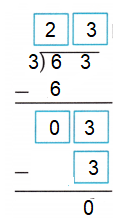
Explanation:
Divide the tens. 63 ÷ 3 Write 2 in the quotient over the tens place.
Multiply. 3 × 2 = 6
Subtract. 6 – 6 = 0
Bring down the ones.
Divide the ones.
3 ÷ 3
Write 1 in the quotient over the ones place.
Multiply 3 × 3= 1
Subtract. 3 – 3 = 0
So, 63 ÷ 3 = 12
Question 2.
![]()
Answer:

Explanation:
Divide the tens.
9 ÷ 7
Write 1 in the quotient over the tens place.
Multiply. 7 × 1 = 7
Subtract. 9 – 7 = 2
Compare. 2 < 7
Bring down the ones.
Divide the ones.
26 ÷ 7
Write 3 in the quotient over the ones place.
Multiply. 7 x 3 = 21
Subtract. 26 – 1 = 5
Compare. 5 < 21
The remainder is 5.
Question 3.
![]()
Answer:

Explanation:
Divide the tens.
6 ÷ 5
Write 1 in the quotient over the tens place.
Multiply. 5 × 1 = 5
Subtract. 6 – 5 = 1
Compare. 1 < 6
Bring down the ones.
Divide the ones.
18 ÷ 5
Write 3 in the quotient over the ones place.
Multiply. 5 x 3 = 15
Subtract. 18 – 15 = 3
Compare. 3 < 15
The remainder is 3.
Algebra Divide to find the unknown number in each equation.
Question 4.
72 ÷ 6 = ___
n = ____
Answer:
n = 12
Explanation:
To isolate the variable in algebra we use inverse operations to manipulate the equation.
So, multiplication is the inverse of division and vice-versa.
72 ÷ 6 = n
n = 12
12 x 6 = 72
Question 5.
45 ÷ 3 = p
p = ___
Answer:
p = 15
Explanation:
To isolate the variable in algebra we use inverse operations to manipulate the equation.
So, multiplication is the inverse of division and vice-versa.
45 ÷ 3 = p
p = 15
15 x 3 = 45
Question 6.
522 ÷ 2 = k
k = ___
Answer:
k = 461
Explanation:
To isolate the variable in algebra we use inverse operations to manipulate the equation.
So, multiplication is the inverse of division and vice-versa.
522 ÷ 2 = k
k = 461
461 x 2 = 522
Problem Solving
Question 7.
A book has 5 chapters and a total of 90 pages. If each chapter has the same number of pages, how many pages are in each chapter?
Answer:
18 pages.
Explanation:
A book has 5 chapters and a total of 90 pages.
Number of pages in each chapter 90 ÷ 5 = 18
Question 8.
Mathematical PRACTICE 2 Reason Caitlin divides a bag of fruit snacks with 4 friends. She divides the 89 snacks equally. How many fruit snacks does each person receive? How many fruit snacks will be left over?
Answer:
Number of fruit snacks does each person receive = 22
Number of fruit snacks will be left over = 1
Explanation:
Caitlin divides a bag of fruit snacks with 4 friends.
She divides the 89 snacks equally.
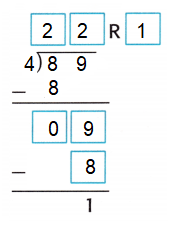
Number of fruit snacks does each person receive = 22
Number of fruit snacks will be left over = 1
Question 9.
Chet is camping with his after-school club. They have 9 tents and 72 people. The same number of campers will be in each tent. How many campers will be in each tent?
Answer:
8 campers.
Explanation:
Chet school club have 9 tents and 72 people.
Number of campers in each tent 72 ÷ 9 = 8
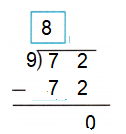
Question 10.
Isaiah helped pick 72 bananas on the weekend. There were a total of 6 people picking bananas. If they each picked an equal number of bananas, how many bananas did each person pick?

Answer:
12 bananas.
Explanation:
Isaiah helped pick 72 bananas on the weekend.
There were a total of 6 people picking bananas.
Number of bananas each person pick = 72 ÷ 6 = 12
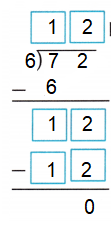
Test Practice
Question 11.
A box of granola bars has 26 bars. If 7 friends split the bars equally, how many bars will be left?
A. 2 bars
B. 3 bars
C. 4 bars
D. 5 bars
Answer:
Option(D)
Explanation:
A box of granola bars has 26 bars.
If 7 friends split the bars equally,
Number of bars equally split 26 ÷ 7 = 3
Multiply: 7 x 3 = 21
Subtract: 26 – 21 = 5
Number of bars left = 5